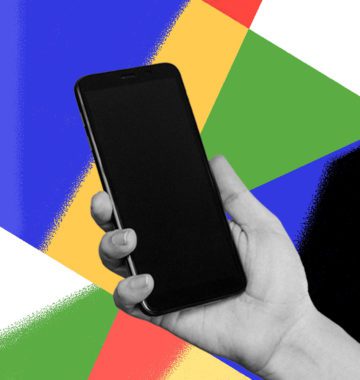This article was updated on April 30th, 2019. To get the most current capabilities of a social media scheduling tool like Buffer or Hootsuite, visit their websites.
A social media scheduling tool is a marketer’s BFF. The tools that I use are there for me when content is plentiful, and when I can’t think of a single thing to post. I couldn’t do my job without them.
Scheduling tools become your constant companions, and I have zero patience for ones that don’t contribute equally to the relationship. I manage multiple social media profiles for Forge and Smith, and also for our clients. But scheduling is just part of what I do in a week, so like most small business social media managers, I need the tools I use to do their jobs — quickly and efficiently.
There are tons of scheduling tools available, and the right one for your business will depend on who needs to use it and what they need to accomplish. I’ve spent a great deal of time on two of the biggest and most trusted platforms: Hootsuite and Buffer.
Here is insight into how these two tools work, complete with personal opinions and rants, to help you choose the best tool for your business.

Post Contents
Social media scheduling tool comparison
Plans
Hootsuite’s Pro plan is suitable for small businesses starting out on social media. Under one login you can connect up to 10 social profiles, get simple analytics reports, add RSS feeds, and do bulk scheduling. The social networks you can connect are Facebook (profiles, pages, groups), Twitter, Instagram (business, personal), YouTube, LinkedIn (profiles, company pages), WordPress blogs, and Pinterest profiles. This will cost you $29.99 a month, which is quite a bit more than the $9.99 this plan started out at — but still doable .
Buffer’s Pro plan is similar. One login allows for 8 social profiles, RSS feeds directly to the dashboard, a post calendar, link tracking and analytics, and built-in tools to create images or upload videos and GIFs. You can connect Facebook (pages, groups), Twitter, Instagram (business, personal), LinkedIn (profiles, company pages), and Pinterest profiles. This plan costs $15 per month.
While Hootsuite’s plan offers more connected profiles (in 2016 the difference was 50 vs. 10, now it’s 10 vs. 8), I’ve never found Buffer’s plan restrictive. Each of our clients has their own Buffer or Hootsuite account, so that they retain full control over scheduled content.
You can test both platforms with a free plan, which comes with a limited number of connected profiles and queued posts.
The Verdict: If you’re regularly using YouTube or WordPress blogging, or a personal Facebook profile, that could be the deciding factor. Otherwise, both plans are great.
Dashboards
Hootsuite’s dashboard is viewed in “streams”, which are customizable. The basic streams are scheduled posts, published posts, and each network’s timeline/feed, but there are fun and hugely efficient additional streams. You can create a stream for mentions to monitor people talking about your business, one for keywords (which literally shows you every tweet or post with that keyword), or one for a Twitter list to view all of members’ content without leaving the dashboard.
I do find the streams, even when viewed in “comfortable” or “standard” mode, to be an overwhelming amount of text, as you can see below in the Pacific Centre for Reproductive Medicine’s dashboard.


Hootsuite also allows you to like, share/retweet, reply-to, and assign any post within the dashboard by clicking the icons under posts as you would in each social network.
Buffer’s dashboard is visually spacious, with a simple stack of social network tabs down the left and four dashboard views along the top, for content, analytics, schedules, and settings. Queues are viewed by default in a top-to-bottom stack. You can toggle from list view to calendar view. There is also a shuffle button, which might be fun if you don’t feel the need to micro-manage your content (which I do).
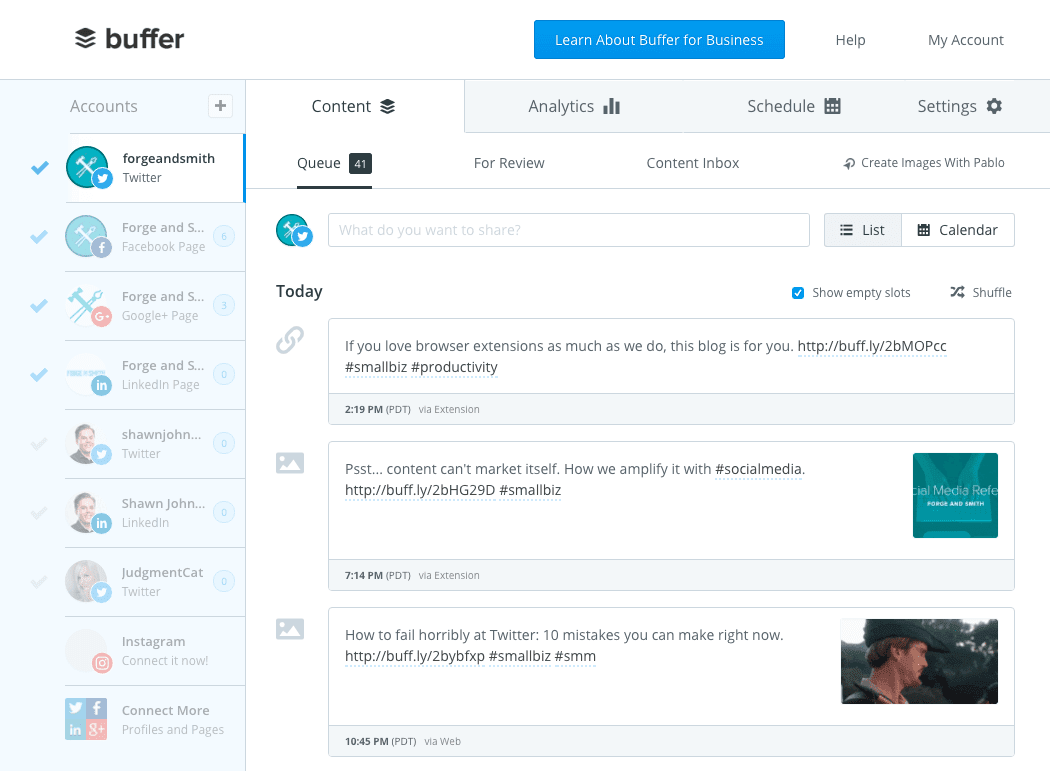

Alas, Buffer doesn’t offer likes, shares, or comments within the dashboard. This doesn’t bother me, but if you have a high volume of notifications per network that require speedy responses, or if you have so many profiles per network to manage that logging in and out is a chore, this would be a downside.
The Verdict: Buffer is better looking (and more user-friendly for beginners). Hootsuite has more bells and whistles, and you rarely have to step outside your dashboard.
Creating & editing content
There are multiple ways you can create a post using each social media scheduling tool, from natively in the dashboard to browser extensions and extensions within third party apps. Let’s look at scheduling directly from the dashboard.
Hootsuite has a simple composition window with social network options and space to write. There is a link shortening box where you can get links shortened before adding them to the message. There are privacy, targeting, media attachment, and calendar options. You can manually set dates and times for posts, or turn on the AutoSchedule tool.


Buffer has as similar composition window, minus targeting options. But possibly the biggest time-saver — and the reason I love Buffer the most — is that it has a drag-and-drop functionality. This allows you to rearrange the posts in your queue in seconds flat simply by dragging them to a new time slot.
This is so fantastic when you want to schedule all of your non-brand content at one time (ex. while reviewing saved articles in Pocket), all of your branded content at another, and then put them into a balanced order when you’re done. It also makes it easy to juggle the queue to fit in new and timely content, like when that new blog post is published.


You’d think editing in the dashboard would be similar to composing, but Hootsuite makes you work to edit posts. First you have to figure out how; in Twitter and Facebook it’s a pencil icon under the text, but for others like LinkedIn it’s the word “edit” in the upper right corner.
Once editing a post, changing the time or date requires manually setting those details. There are lags while streams refresh to update content for both new and edited posts, which also pops you back to the top of the stream. This is problematic when scrolling through 50 scheduled tweets to make changes.
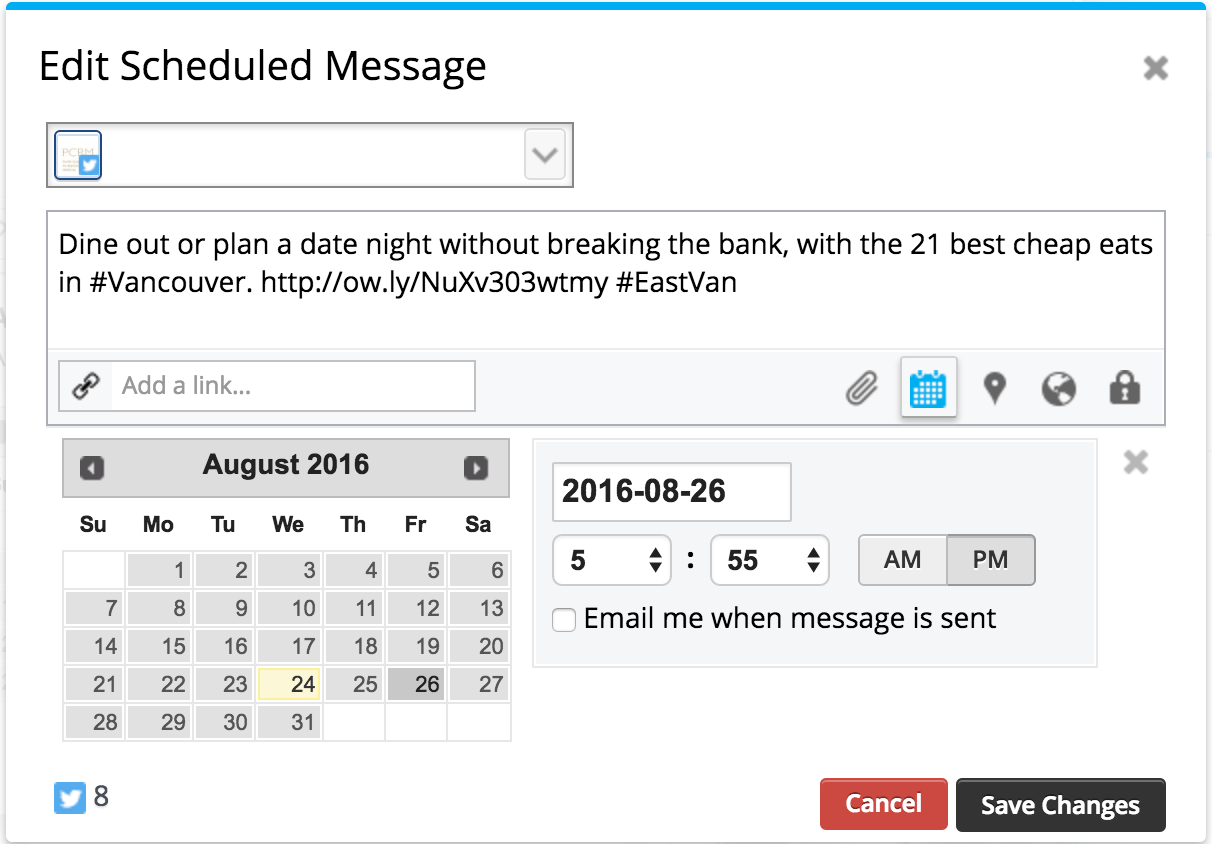
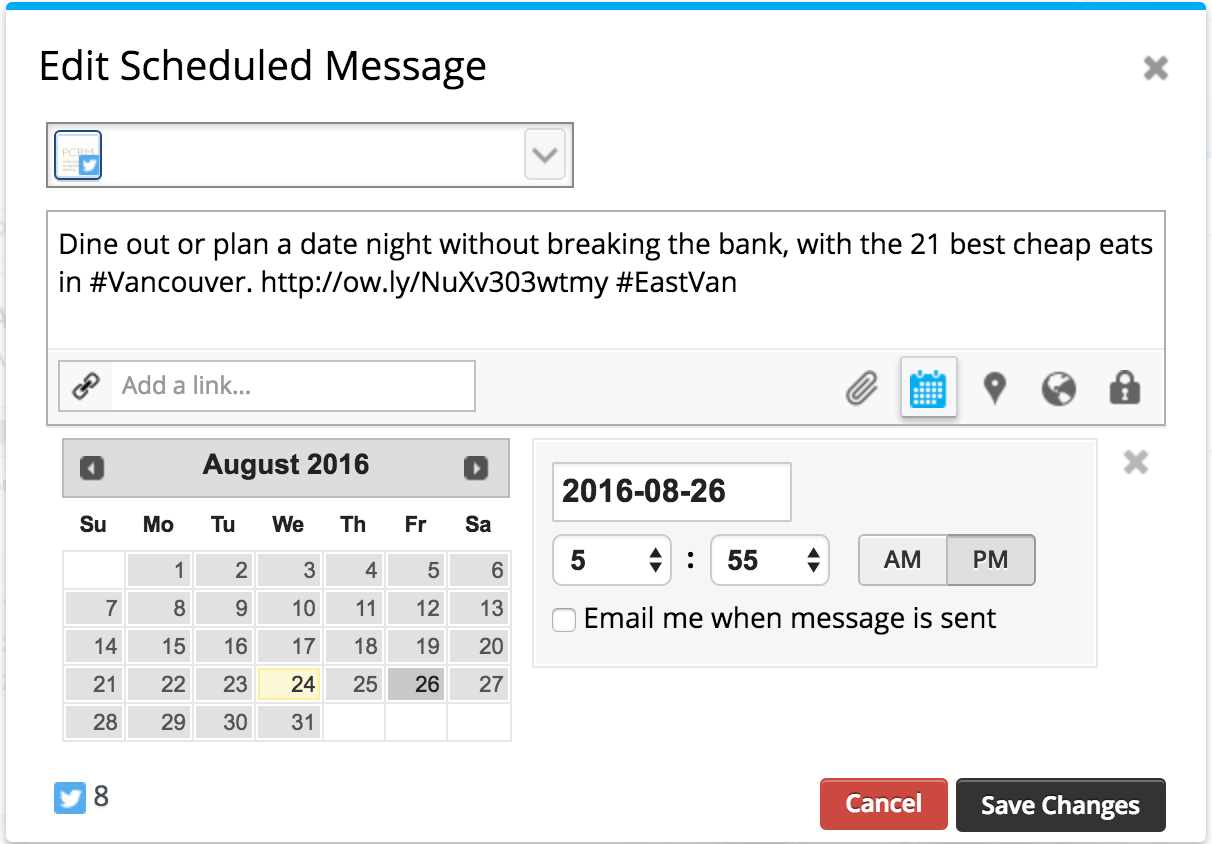
Buffer couldn’t make editing easier if it tried. Clicking anywhere within a queued post allows you to edit any part of it (text, media), time and date are changed by dragging the post to a new location, and you can delete or “share now” from the dashboard in one click.
The Verdict: Time is money. Buffer wins by a landslide.
Scheduling posts
Once Hootsuite’s AutoSchedule tool is configured, you can schedule posts between certain hours on specified days. The time window can’t differ between days. If you’re picky about spreading out owned content and non-brand content, or having your best content (obviously your own) publish at certain times, this is not for you. You’ll have no control over timing or order, so your only option is to manually set each post as you compose it.


Buffer lets you create custom schedules for each social network, and even for each day of the week. You can post four times per day on Tuesday, and three different times on Saturday. All of the content you schedule through the mobile app, desktop app, or using the browser extension will automatically move to the next available time slot per network.
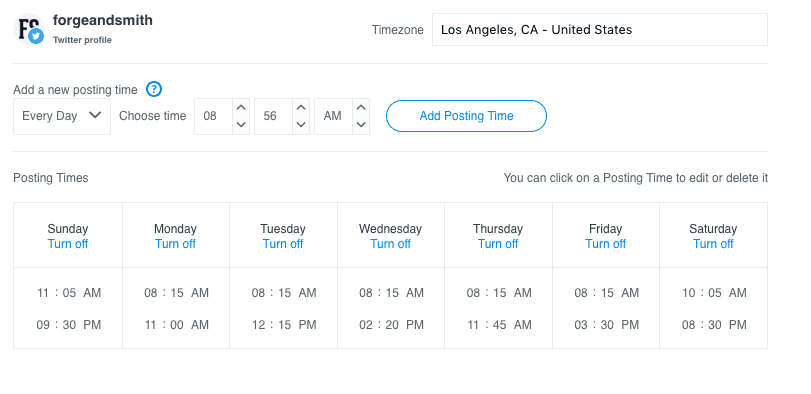

If you want to copy a post to another social network after it has already been created, Hootsuite allows you to do that by editing the post (remember that lengthy process?) and selecting other networks. In Buffer, you can drag the post over the network icon in the left column and it will drop neatly into that queue.
The Verdict: Once again, Buffer takes the gold.
Analytics
Analytics are a huge part of my job. I seriously dig data. You should know by now that social media likes don’t matter, and of course you’re looking at the real story beneath your numbers.
Hootsuite’s “key performance metrics” are available through report templates. You can create reports for engagement, insights, and more. Only the profile overviews — the same ones you can get from each social network’s analytics — are free. All of the detailed, exportable reports require an upgrade to a pricier plan. They just leave them there to tempt you with their sexy numbers.
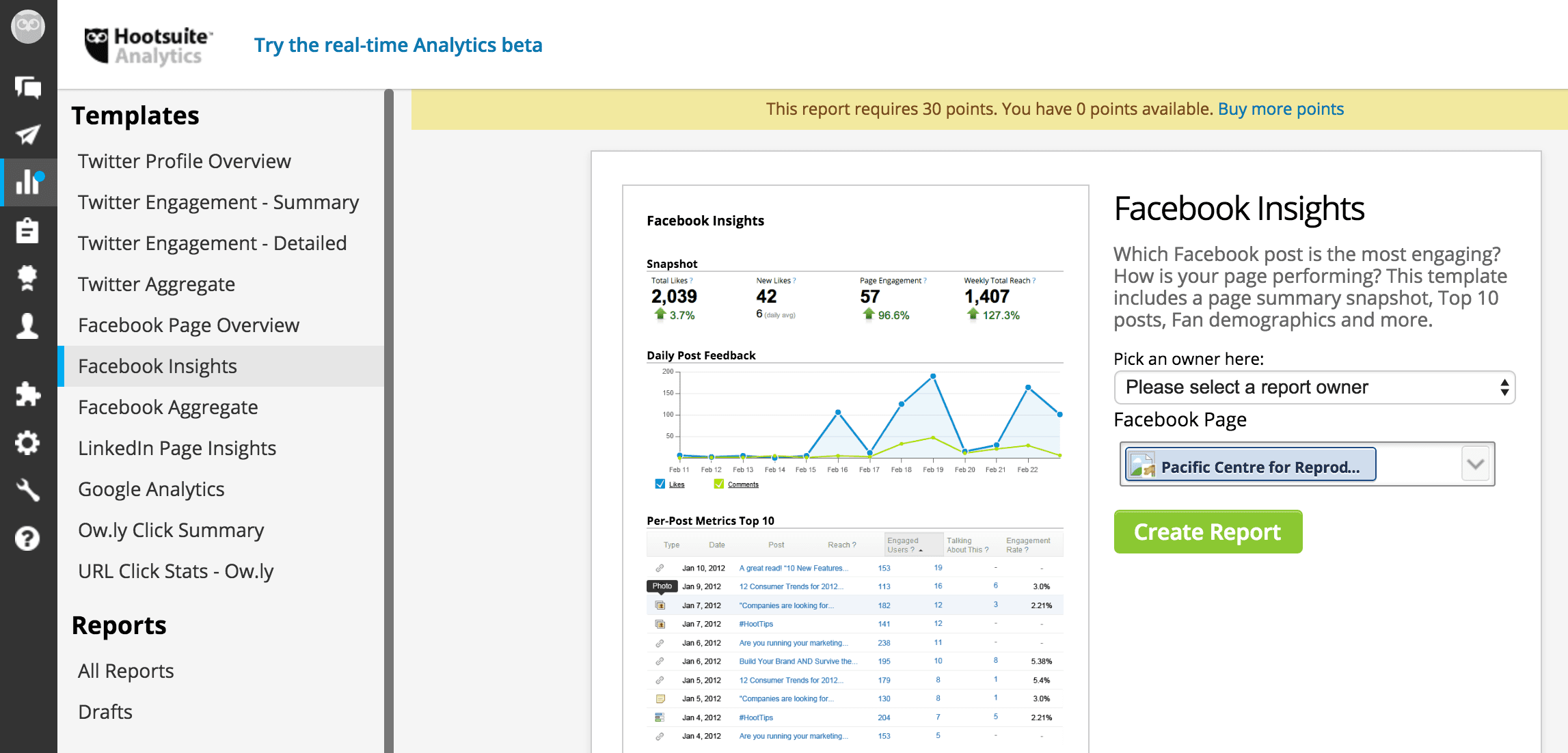

Buffer’s Pro plan allows you to view basic analytics for every single post on each profile in one handy, attractive column that’s just one click away from your queue view. The deeper data that was previously included with the Pro plan (under Analysis and Insights, below) is now limited to Business level or higher. Looks like both tools are seeing the value of data, and locking it away from the people generating it…


I will say this: right next to each post in the Buffer analytics stack is the best button ever: “Re-Buffer”. This lets you move top performing posts — which it indicates — back into your queue(s).
Generating a data report does require upgrading to Buffer for Business, like it does with Hootsuite. If your boss needs detailed social analytics reports, you will have to shell out for a bigger Hootsuite or Buffer plan.
The Verdict: Both social media scheduling tools are equal in their limited reporting at the ‘affordable’ level.
Browser extensions
Browser extensions make the world go ’round, in my opinion. Show me a social media manager who doesn’t love a time-saving tool, and I’ll show you a crazy person.
Both Hootsuite’s and Buffer’s browser extensions operate similarly. When viewing content you click on the browser extension in your toolbar and a composition window pops up. If you’re using Hootsuite’s AutoSchedule tool and Buffer’s custom schedule, scheduling a post would be as simple as one click to add them to your queues.
![]()
![]()
![]()
![]()
If your time is precious, Hootsuite can make you sweat. While reading articles and dropping them into the queue, AutoSchedule would place them in the order you scheduled them unless you entered the dates and times manually. Doing so requires checking your queue in a separate tab to see which spots are available on each day (to ensure a healthy branded and non-branded content balance), or allowing the AutoSchedule queue to fill up and then manually changing the dates and times later to spread out promotional and non-brand content.
If that was exhausting to read, imagine how exhausting it is to do! I speak from experience.
![]()
![]()
![]()
![]()
Buffer will also place posts in the order in which you created them, but it has that drag-and-drop functionality that makes rearranging them painless. I typically schedule all of our branded content first, dropping it into time slots (set by my glorious custom schedules) spread out over a week or two. Then I move on to non-brand sources curated from Pocket or feedly, allowing them to fill up the open spaces in each day as I add them through the browser extension.
![]()
![]()
![]()
![]()
The Verdict: If balance and order aren’t among your priorities, both extensions are created equally. Buffer’s is better simply due to the tool’s native scheduling efficiency.
App integration
Hootsuite now integrates with over 150 apps to make it easier to schedule content right within the apps themselves. Buffer has also upgraded to include the same type of offering, with a slightly different selection of apps.
The Verdict: I’m ‘appy to report that both tools are equal.
Branding, merchandise & customer care
While branding and merch have nothing to do with how well a social media scheduling tool performs, they do make it easy to fall in love with a product. And customer care is essential for tools that are so crucial to your work.
Hootsuite’s branding is recognizable and a lot of fun. Forge and Smith designer Damian couldn’t wait to meet Owly at Social Media Marketing World! With collectible takeaways like stickers, quality earbuds, and the adorable stuffed Owly, Hootsuite has branding on lock.


Buffer’s merch doesn’t hold up, but then again, who wants to cuddle up to a stuffed ‘wireframe toolbar’ icon? The stickers are fun decorations, though.
Buffer has exceptional customer care, which is important when you need help with your account. Their email support is speedy and efficient, and their personalized tweets are adorable. You definitely feel like you’re in good hands with the Buffer team.


I hope that this thorough report has shed some light on the awesome benefits of using a social media scheduling tool to save time and energy for other social tasks. Some other tools worth checking out are agora pulse, Post Planner, and Sprout Social.
What’s the social media tool you can’t live without? We’d love to hear about it. Tweet to us @forgeandsmith.







